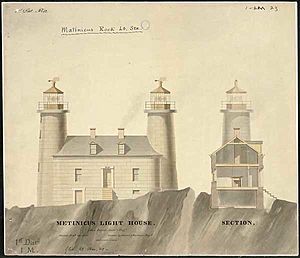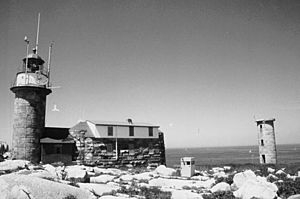Matinicus Rock Light facts for kids
 |
|
| Matinicus Lighthouse, drawn in March 1848 | |
|
|
|
| Location | 6 miles south of Matinicus Island, Town of Criehaven, Maine |
|---|---|
| Coordinates | 43°47′.502″N 68°51′18.119″W / 43.78347278°N 68.85503306°W |
| Year first constructed | 1827 |
| Year first lit | 1846 (current tower) |
| Automated | 1983 |
| Foundation | Natural emplaced |
| Construction | Granite blocks |
| Tower shape | Cylindrical twin towers |
| Markings / pattern | Natural |
| Focal height | |
| Original lens | Third order Fresnel lens |
| Current lens | VRB-25 |
| Range | 20 nautical miles (37 km; 23 mi) |
| Characteristic | Flashing white 10s |
| Fog signal | HORN: 1 every 15s, operates continuously. |
| Admiralty number | J0116 |
| ARLHS number | USA-484 |
| USCG number | 1-10 |
The Matinicus Rock Light is a lighthouse located on Matinicus Rock. This rock is a windy, treeless island about 25 miles (40 km) off the coast of Maine. It is one of eleven lighthouses along Maine's coast. The first lighthouse here was built in 1827. The buildings you see today were built in 1857. This lighthouse was added to the National Register of Historic Places in 1988.
Contents
What Matinicus Rock Looks Like
Matinicus Rock is a very windy island. It sticks out of the Gulf of Maine. The island is several miles south of the main islands of Matinicus Isle, Maine. Matinicus Isle is an island community. You can reach it by a 20-mile (32 km) ferry ride from Rockland.
The lighthouse station sits in the middle of Matinicus Rock. It has two tall towers. There is also a house for the lighthouse keeper. Other buildings include a shed and a boathouse. The dock for boats is on the northwest side of the rock.
The two lighthouse towers are 41 feet (12 m) tall. They are made from strong granite stone. Only the southern tower is still active today. It has a lantern room with twelve sides. The other tower no longer has its lantern room. The keeper's house is connected to the active tower. It is a one-story building. Its end walls are rounded granite structures. These are parts of the older lighthouses.
A Brief History of the Lighthouse
In 1827, the United States Lighthouse Service built the first lighthouse here. It had two wooden towers. There was also a cobblestone house for the keeper. These lights helped guide ships.
In 1848, new granite structures replaced the old ones. Then, in 1857, the government rebuilt the towers again. They placed them 180 feet (55 m) apart. This made them work even better. The north light was turned off in 1924. Alexander Parris designed the 1848 lighthouses. He also designed many stone buildings in New England. One famous building is the 1825 Quincy Market in Boston, Massachusetts.
The Story of Abbie Burgess
Matinicus Light is famous for the story of Abbie Burgess. She was a young girl who lived at the lighthouse. Her father was the lighthouse keeper. One winter, he went to the mainland. Bad storms kept him from returning. Abbie's mother was also very sick. So, Abbie bravely took care of the lighthouse for several weeks all by herself.
Modern Times at Matinicus Rock
Today, Matinicus Rock Light is fully automated. This means no one lives there to operate it. A diesel generator used to power the light. But in 2007, it was replaced by solar panels. This makes the lighthouse more environmentally friendly.
Matinicus Rock is also special for wildlife. It is the southernmost place where Atlantic puffins nest. As of 2009, common murres also nest there. The Audubon Society often has people observing the birds. They visit the island during nesting season.



